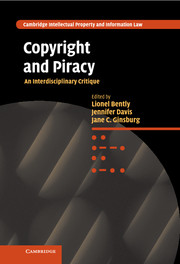Book contents
- Frontmatter
- Contents
- Notes on the contributors
- Editors' preface
- Table of cases
- Table of statutes
- Part I Introduction
- Part II History
- Part III Comparative Law
- Part IV Economics
- Part V Linguistics
- Part VI Computer software
- Part VII Information studies
- Part VIII Literature
- Part IX Art
- Part X Sociology/music
- 18 Reggae open source: how the absence of copyright enabled the emergence of popular music in Jamaica
- 19 ‘Free-riding on the riddim’? Open source, copyright law and reggae music in Jamaica
- Part XI Criminology
- Bibliography
- Index
18 - Reggae open source: how the absence of copyright enabled the emergence of popular music in Jamaica
from Part X - Sociology/music
Published online by Cambridge University Press: 17 November 2010
- Frontmatter
- Contents
- Notes on the contributors
- Editors' preface
- Table of cases
- Table of statutes
- Part I Introduction
- Part II History
- Part III Comparative Law
- Part IV Economics
- Part V Linguistics
- Part VI Computer software
- Part VII Information studies
- Part VIII Literature
- Part IX Art
- Part X Sociology/music
- 18 Reggae open source: how the absence of copyright enabled the emergence of popular music in Jamaica
- 19 ‘Free-riding on the riddim’? Open source, copyright law and reggae music in Jamaica
- Part XI Criminology
- Bibliography
- Index
Summary
Since 1960 a highly innovative form of music making has developed in Jamaica in the effective absence of copyright. Over the first two-thirds of the chapter I argue that in fact reggae music would never have emerged had copyright been implemented on the island. Quite simply, local forms of creativity and the nature of the musical labour process were inimical to intellectual property (IP). In the last section, I go a step further by suggesting there are wider lessons to be learned here. Creative practice in Jamaica has been based on principles which may well apply in other territories and to other forms of culture choked by the constrictions of the contemporary copyright regime. A comparison with open-source software reinforces this case.
On Orange street: political economy at the birth of reggae
In 1960 the music industry in Kingston, Jamaica was still at an embryonic stage. The main form of music entertainment, however, was distinctly modern. Across the city black working-class people danced to recorded music. This was provided by mobile sound systems, consisting of a record deck, amplifier and large loudspeaker boxes, together with operating crew and truck to carry the equipment. The sound systems constituted a highly competitive market, where what counted was the playing of new and exclusive rhythm and blues records from the US. Audiences provided immediate feedback in the form of getting up to dance – or not – and the fortunes of a sound depended on its ability to keep audiences moving.
- Type
- Chapter
- Information
- Copyright and PiracyAn Interdisciplinary Critique, pp. 357 - 373Publisher: Cambridge University PressPrint publication year: 2010
- 4
- Cited by

